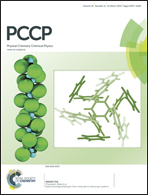Hydrogen storage on metal oxide model clusters using density-functional methods and reliable van der Waals corrections†
Abstract
We investigate the capability of low-coordinated sites on small model clusters to act as active centers for hydrogen storage. A set of small magic clusters with the formula (XY)6 (X = Mg, Ba, Be, Zn, Cd, Na, Li, B and Y = O, Se, S, F, I, N) and a “drumlike” hexagonal shape showing a low coordination number of three was screened. Oxide clusters turned out to be the most promising candidates for hydrogen storage. For these ionic compounds we explored the suitability of different van der Waals (vdW) corrections to density-functional calculations by comparing the respective H2 physisorption profile to highly accurate CCSD(T) (Coupled Cluster Singles Doubles with perturbative Triples) calculations. The Grimme D3 vdW correction in combination with the Perdew–Burke–Ernzerhof exchange–correlation functional was found to be the best approach compared to CCSD(T) hydrogen physisorption profiles and is, therefore, suited to study these and other light metal oxide systems. H2 adsorption on sites of oxide model clusters is found to meet the adsorption energy criteria for H2 storage, with bond strengths ranging from 0.15 to 0.21 eV. Energy profiles and estimates of kinetic constants for the H2 splitting reaction reveal that H2 is likely to be adsorbed molecularly on sites of (MgO)6, (BaO)6, and (BeO)6 clusters, suggesting a rapid H2 uptake/release at operating temperatures and moderate pressures. The small mass of beryllium and magnesium makes such systems appealing for meeting the gravimetric criterion for H2 storage.


 Please wait while we load your content...
Please wait while we load your content...